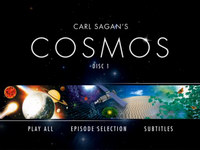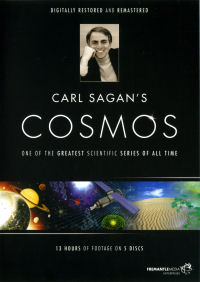
9.3.2014 #487 / #575
German original from 25.8.2010
by Guido Bibra
• Science Updates
![]() The Documentary Series
The Documentary Series
American television has never shied away from superlatives, but sometimes impulses for new ideas also came from Europe. One genre which had been long underrepresented on the US television screens were documentaries, which already were very common in Europe and especially England since the 1950s. The BBC had literally invented the blockbuster documentary in the late 1960s with series like The Ascent of Man and Civilisation, which together with the natural history programs of the former BBC controller David Attenborough had completely revolutionised the television industry. In 1979, Attenborough had set completely new standards with his landmark series Life on Earth, but in the USA there was also something happening.
It was the scientist, astronomer and writer Carl Sagan, who also had the idea of making a blockbuster documentary at about the same time. This was not completely unselfish, because as a professor working at Cornell University in New York his research and teaching was dependent on public funds, which could best be ensured by the popularisation of science. Sagan was also involved in many of the unmanned NASA missions of the 1970s as an important contributor to the phenomenal successes of the Mariner, Voyager and Pioneer programs, which would have not existed without tax money.
Carl Sagan was, however, not someone hiding behind his work, but made it his personal mission to make science accessible to everybody and thereby call attention to the importance of public science funding. While he had already begun to write popular science books since the beginning of the 1970s, the best method to reach the public was always television. Therefore Carl Sagan had already explored the possibility of a comprehensive television series modelled after the British productions, but encompassing not only natural history, but also science, astronomy and cosmology.
This concept was very risky for the American television industry, but Carl Sagan still managed to convince PBS, the only non-commercial network in the USA, about it. For the 13-part mammoth project an astronomical budget of six million dollars was provided and a new company formed, which produced the series in cooperation with KCET, the Los Angeles affiliate of PBS. Support also came from the British BBC and the German company Polytel International, making the series a truly international production which was also pre-sold to many television companies and stations all around the world.
The simple title Cosmos explained the scope of the series right at the beginning. Carl Sagan did not really want to give the literal answer to life, the universe and everything like Douglas Adams later satirically told in his Hitchhiker's Guide to the Galaxy novels, but he certainly made a good effort to try. The subtitle A Personal Voyage also underlined his very personal wish to make scientific knowledge and achievements understandable for the mainstream audience. Like his British precursors, he also acted as a presenter and spoke directly to the audience in person, but without patronizing them. While Cosmos was intended as a scholarly program, it also was supposed to be compelling entertainment at the same time.
Carl Sagan worked on the unique concept of the series together with his university colleague Steven Soter and the journalist (and later wife) Ann Druyan, who made sure that the numerous complex themes were presented in a way easily understandable for everybody, but still on a certain level. In order to prevent Cosmos becoming a dull lecture, a mix of documentary material, dramatised scenes of historical events, elaborate special effects and Carl Sagan's personal appearances were utilized, something which had seldom been attempted before in American television.
Carl Sagan, Steven Soter and Ann Druyan were able to cover as much ground as possible in the thirteen hour-long episodes. Besides a lot of visually explained theory from biology, chemistry and physics, the series took the viewer on a journey through the whole universe from the earth itself to the furthest stars, planets and galaxies. The history of science and scientific discoveries were also a major part of Cosmos, which brought the audience deep into the past with many lavishly produced short films depicting famous and even mostly unknown historical events.
Much of this was only possible with special effects almost revolutionary for a television series at that time - a journey through the galaxy in an imaginary spaceship would not even have been remotely possible only a few years previously. The effects, produced in collaboration with NASA and the Jet Propulsion Laboratory, allowed Carl Sagan to visit a partly computer generated portrayal of the lost library of Alexandria, walk around on the huge cosmic calendar or go to far-away planets. But not everything was created with computer-generated special effects, because good old-fashioned studio sets, elaborate hand-drawn artwork and even traditionally animated sequences also were integral parts of Cosmos and contributed much to its unique charm and atmosphere.
In contrast to the British counterparts, there was no new music produced for Cosmos, but the score still played an important part in the series. Instead, Carl Sagan, Steven Soter and Ann Druyan chose the works of the Greek composer Vangelis, whose synthesizer-heavy instrumentals provided exactly the right atmosphere for the series. Mostly used were tracks from his 1975 album Heaven and Hell, the warm and epic Movement 3 was selected as a signature title tune and became one of the most recognizable trademarks of Cosmos. Also, a lot of archive music from many classical composers was used, but from then on, the music of Vangelis became inseparable from Cosmos and helped to make the composer very popular all over the world.
Despite all technical efforts, Cosmos above all relied on the presence of Carl Sagan himself, who was a brilliant narrator and very much an equal to his British counterparts like David Attenborough. He was easily able to talk through the enormous amounts of text without boring the audience, because he always displayed honest enthusiasm showing that he stood behind everything what he said with full conviction. Despite this very personal approach, Cosmos was far away of just being a simple self-portrayal of Sagan, because his intent of bringing his own knowledge into the wide public stood in the foreground more than anything else.
Cosmos was first broadcast by PBS all over the USA in late 1980 and immediately produced astronomical ratings. This was mainly thanks to a substantial promotional campaign, which helped enormeously to make the series extremely popular. Cosmos was even recommended as teaching material, one of its original target groups, but there was also some criticism. Several scientists bemoaned simplified facts and one-sided perspectives, conservatives were also enraged by Sagan's strong statements about religion, astrology and creationism - but rational voices were in the majority and praised Cosmos as the breakthrough television event it really was. The series even won a very much deserved Emmy and also the much coveted Peabody Award.
Accompanying the series was also a book with the same title. Although it was based on the television series, it was not simply a text version of it, but a fully independent publication with broadly the same themes and thirteen-part structure. The written format together with extensive illustrations allowed Carl Sagan to go even more into detail than in the television series and soon the book became equally successful. It was one of the first science books becoming a bestseller with around five million copies sold alone in the USA. The book and the television series both helped each other gain enormous popularity and for literally decades Cosmos in both incarnations inspired countless people to embark on science careers.
Cosmos also became very successful outside North America. The series was sold to over sixty countries and was seen by 500 million people - albeit sometimes only in mutilated versions. The BBC as a co-producer screened the series in 1981, but shortened the episodes to 50 minutes. In Germany, Unser Kosmos (Our Cosmos) was broadcast only in 1983 in a badly translated version cut down to 43 minutes per episode and with Tom Sellecks German voice actor Norbert Langer being only a weak substitute for Carl Sagan. It seems that for this reason the series was only repeated once in 1988 and has since never been seen again on German television screens.
Even in the USA, Cosmos was not immune to modifications. When the cable television giant Turner bought the series in 1991 for broadcasts across its network, a completely new version was created, editing the original thirteen hour-long episodes into six 45-minute installments. Although Carl Sagan had worked with Turner Television to create this new edition with some updated special effects and even some new material, due to the heavy shrinking this so-called special edition was not comparable to the original series - but it was also not meant to completely replace it.
Carl Sagan had always seen Cosmos as one of his most important works and by establishing the Cosmos Studios made sure that the series never vanished completely. When he unfortunately died much too early in 1996 after a long fight against a rare bone marrow disease, his wife Ann Druyan carried on his work and finished the long-prepared project to compile a final and definitive edition of Cosmos. For this, the original broadcast version from 1980 was carefully restored and some updated elements from the 1989 special edition were incorporated together with the science updates recorded by Carl Sagan himself in 1991. After some issues with the music rights were resolved which had prevented some earlier home video releases, the restored version of Cosmos with the subtitle Collector's Edition was finally finished in 2001 and shown on American television again after a long time. In 2002, Cosmos Studios also released the series on DVD for the first time.
Over thirty years after its making, Cosmos may seem visually outdated and some of the science has since been superseded by new findings, but the series is still very relevant and has otherwise aged surprisingly well. There are only few other documentaries in which astronomy, cosmology and the many related themes are presented in such a thorough and entertaining way. With his driving force, Carl Sagan gave Cosmos a unique identity and while it remained his only big documentary endeavour, he managed to bring science to a public audience in a brilliant way, reaching a popularity almost approaching immortality.
Almost 35 years after the original, 2014 brings a new version of Cosmos created by Ann Druyan and Steven Soter with the help of Seth McFarlane. Astrophysicist Neil deGrasse Tyson was selected as a successor to Carl Sagan because he has the same infectious enthusiasm about the popularization of science and astronomy. To capture a new generation of audiences, a refurbished incarnation of the series was simply unavoidable, but only time will tell if the new Cosmos will have the same impact the original had thirty years ago.
The Episodes
- The Shores of the Cosmic Ocean - A journey in the spaceship of the imagination through the whole universe with the destination Earth, whose history is brought into perspective with the cosmic calendar
- One Voice in the Cosmic Fugue - The evolution of life on earth and possible kinds of alien life in the universe
- The Harmony of the Worlds - The history of astrology and astronomy
- Heaven and Hell - Astronomical collisions and the discovery of the planet Venus
- Blues for a Red Planet - The history of Mars and its perception in human history
- Traveller's Tales - Expeditions on Earth and in the solar system
- The Backbone of the Night - The discovery of stars and planets
- Journeys in Space and Time - Space, time, relativity, time travel and the vastness of space
- The Lives of the Stars - The creation of stars and their several stages of life
- The Edge of Forever - The big bang, the galaxies and the universe
- The Persistence of Memory - The evolution of intelligent human life and the occurence of natural and human libraries
- Encyclopaedia Galactica - The UFO hysteria, the search for extraterrestial life and the possibility of intelligent life in the universe
- Who speaks for Earth? - The rise and fall of human civilisations and the effects on the future of mankind
![]() The DVD
The DVD
After only few VHS and Laserdisc releases in the 1980s and 1990s, Cosmos was finally released on DVD in the USA in 2002. While this long-awaited boxset it region free and even has many international subtitles including German, as an independent production of Cosmos Studios it has always been very expensive. In 2009 the British studio Freemantle Media had, however, released a Region 2 version which is available for only a fraction of the US price and has a few negligible disadvantages.
In fact, the Cosmos DVDs reviewed in this article are almost completely identical to the US version, because only the isolated music track and the foreign-language subtitles are missing. All thirteen episodes are present in their final versions, taken from the same restored video masters used on the American discs - even the NTSC-to-PAL conversion is almost unnoticeable and the overall quality is as perfect as the source material allows. The packaging is, however, limited to a double-thick clear keepcase with five trays instead of a more elegant digipack, but Freemantle has at least cared for a worthy cover and disc art design. The british DVD release of Cosmos is therefore very much recommended and at a price of less than £10 should belong in every dvd collection.
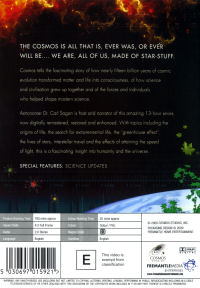
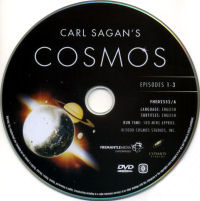

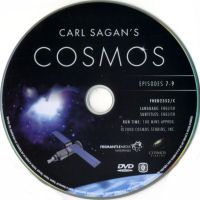

![]() Image
Image
Cosmos had been produced between 1978 and 1979 on a then very common mix of film and video, and the whole post-production and integration of the special effects was also done on videotape only. Because of this, only the NTSC master tapes were able to be used for this DVD, although these had already been carefully remastered for the American DVD release. The image still has typical age-related limitations, but looks surprisingly good and has not even suffered much from the needed NTSC to PAL conversion on this British DVD.
On first glance it is very noticeable that the image is not as fuzzy as could be expected from an over thirty year old video master. While sharpness is not in the least compareable with current productions and is even more reduced during the scenes probably filmed on 16mm, most of the video sequences look pretty good. Some of the special effects could, of course, be more detailed and some of the computer graphics look rather rustic, but overall sharpness is very acceptable. No additional digital sharpening was applied.
While detail could not be really improved with the remastering process, the image has been thoroughly cleaned. Especially the sequences shot on film were liberated of any scratches, dirt or other blemishes and the videotaped scenes were carefully treated with a filter - although darker scenes still exhibit some analogue video noise, most of these leave a very clean impression. There is no typical composite dot crawl and only a slight smearing effect on bright image sections.
How the UK DVDs were converted from NTSC to PAL is unknown, but the runtime of the episodes is the same as on the US release so there must have been some conversion from 60 to 50 frames per second. This was done very carefully, because there is no ghosting or other unpleasant artifacts visible at all and the image seems to actually be encoded progressively at 25 frames per second. It looks like Freemantle Media has taken great care to make the conversion as flawlessy as possible so that their release of Cosmos has no visual disadvantages compared to the US release. Although the first four DVDs harbour over three hours of material, the bitrate of about 6 mbit/s is still high enough to ensure that there are no compression artifacts visible at all.
Of course these over three decades old videotape masters are no high-definition material, but the remastering process has ensured that the series can be viewed in a quality quite respectable for its age. Furthermore, the most important thing of Cosmos are not really the visuals, but the contents itself, so these DVDs are more than satisfactory.
![]() Sound
Sound
In contrast to the American DVD release, Freemantle's version of Cosmos does not have a 5.1 audio mix, but instead a very good stereo-surround-mix with a remarkably solid sound is provided.
The lone English 2.0 soundtrack has been encoded with a generous 224 kbit/s and is actually not only a stereo mix, but a full-blown surround track which is best played back through a ProLogic decoder with a 3.1 setup. The surround sound is, of couirse, mainly created by the music, having an excellent frequency response and a very distinct dynamic closely resembling an audio CD. The matrixcoded surround channel is, however, not only used by the music, but also by some diffuse sound effects.
The sound of Carl Sagan's voice is, however, a little disappointing and does not integrate well into the otherwise crystal-clear sounding track. This is, however, less a fault of the soundtrack than the voice recording itself, which obviously was not done unter optimal circumstances and thereby sounds unusually muffled, but not really thin or distorted. Luckily, this does not have serious effects on the intelligibility, because Carl Sagan's careful pronounciation is not affected by the somewhat reduced voice quality.
Because the Freemantle DVD of Cosmos is a purely british release, only English subtitles are provided, but these are very accurate.
![]() Extras
Extras
Like its American counterpart, the british Cosmos DVD does not actually have any real extras, because the supplements are actually part of the episodes - but the real bonus material is actually the whole series itself. The menu design is simple, elegant and effective.
Disc one contains a short Series Introduction from Ann Druyan, which was originally recorded for the 2000 Collector's Edition. All episodes except 1, 3, 7 and 11 also have short, 2-4 minute Science Updates, which were recorded by Carl Sagan in 1991. Originally, these short additions were part of the episodes, so the separated menu entry on the British DVDs are somewhat confusing because the episodes with these updates abruptly close without the ending credits, which come after the Science Updates.
